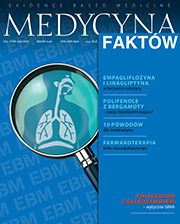Bergamot polyphenolic fraction (BPF) – can it be a therapeutic option for selected patients with lipid metabolism disorders? – analysis of clinical cases Case series report
Main Article Content
Abstract
Lipid metabolic disorders are one of the most common cardiovascular risk factors. The basis for the treatment of dyslipidemia is lifestyle modification and, in selected patients – pharmacotherapy with the use of statins. In some patients, non-pharmacological treatment is not effective enough and their overall cardiovascular risk is relatively low. In such patients, there is no indication for statin therapy and functional food and dietary supplements could be the therapeutic option. One of the new and relatively well-tested dietary supplements is bergamot polyphenolic fraction (BPF). The article analyzes the results of the use of BPF in 3 patients with various stages of lipid disorders.
Article Details
How to Cite
Janiszewski , M., Chmielewski , M., & Mamcarz , A. (2019). Bergamot polyphenolic fraction (BPF) – can it be a therapeutic option for selected patients with lipid metabolism disorders? – analysis of clinical cases. Medycyna Faktow (J EBM), 12(3(44), 197-203. https://doi.org/10.24292/01.MF.0319.2
Issue
Section
Articles
Copyright © by Medical Education. All rights reserved.
References
1. Pająk A., Szafraniec K., Polak M. et al.: WOBASZ Investigators. Changes in the prevalence, treatment, and control of hypercholesterolemia and other dyslipidemias over 10 years in Poland: the WOBASZ study. Pol. Arch. Med. Wewn. 2016; 126(9): 642-652.
2. Szymański F.M., Barylski M., Cybulska B. et al.: Rekomendacje dotyczące leczenia dyslipidemii w Polsce – III Deklaracja Sopocka. Interdyscyplinarne stanowisko grupy ekspertów wsparte przez Sekcję Farmakoterapii Sercowo-Naczyniowej Polskiego Towarzystwa Kardiologicznego. Choroby Serca i Naczyń 2018; 15(4): 199-210.
3. Piepoli M., Hoes A., Agewall S. et al.: 2016 European Guidelines on cardiovascular disease prevention in clinical practice. Eur. Heart J. 2016; 37(29): 2315-2381.
4. Barylski M., Filipiak K.J., Okopień B. et al.: Stanowisko grupy ekspertów wsparte przez Sekcję Farmakoterapii Sercowo-Naczyniowej Polskiego Towarzystwa Kardiologicznego dotyczące miejsca standaryzowanej kompozycji polifenoli z bergamoty w terapii dyslipidemii oraz jej innego potencjalnego zastosowania w praktyce klinicznej. Folia Cardiologica 2018; 13(3): 222-235.
5. Gliozzi M., Carresi C., Musolino V.: The effect of bergamot-derived polyphenolic fraction on LDL small dense particles and non-alcoholic fatty liver disease in patients with metabolic syndrome. Adv. Biol. Chem. 2014; 4: 129-137.
6. Ibanez B., James S., Agewall S. et al.: Wytyczne ESC dotyczące postępowania w ostrym zawale serca z uniesieniem odcinka ST w 2017 roku. Kardiol. Pol. 2018; 76(2): 229-313.
7. Mollace V., Sacco I., Janda E. et al.: Hypolipemic and hypoglycaemic activity of bergamot polyphenols: from animal models to human studies. Fitoterapia 2011; 82(3): 309-316.
8. Gliozzi M., Walker R., Muscoli S. et al.: Bergamot polyphenolic fraction enhances rosuvastatin-induced effect on LDL-cholesterol, LOX-1 expression and protein kinase B phosphorylation in patients with hyperlipidemia. Int. J. Cardiol. 2013; 170(2): 140-145.
9. Catapano A.L., Graham I., De Backer G. et al.: ESC Scientific Document Group. 2016 ESC/EAS Guidelines for the management of dyslipidaemias. Eur. Heart J. 2016; 37(39): 2999-3058.
2. Szymański F.M., Barylski M., Cybulska B. et al.: Rekomendacje dotyczące leczenia dyslipidemii w Polsce – III Deklaracja Sopocka. Interdyscyplinarne stanowisko grupy ekspertów wsparte przez Sekcję Farmakoterapii Sercowo-Naczyniowej Polskiego Towarzystwa Kardiologicznego. Choroby Serca i Naczyń 2018; 15(4): 199-210.
3. Piepoli M., Hoes A., Agewall S. et al.: 2016 European Guidelines on cardiovascular disease prevention in clinical practice. Eur. Heart J. 2016; 37(29): 2315-2381.
4. Barylski M., Filipiak K.J., Okopień B. et al.: Stanowisko grupy ekspertów wsparte przez Sekcję Farmakoterapii Sercowo-Naczyniowej Polskiego Towarzystwa Kardiologicznego dotyczące miejsca standaryzowanej kompozycji polifenoli z bergamoty w terapii dyslipidemii oraz jej innego potencjalnego zastosowania w praktyce klinicznej. Folia Cardiologica 2018; 13(3): 222-235.
5. Gliozzi M., Carresi C., Musolino V.: The effect of bergamot-derived polyphenolic fraction on LDL small dense particles and non-alcoholic fatty liver disease in patients with metabolic syndrome. Adv. Biol. Chem. 2014; 4: 129-137.
6. Ibanez B., James S., Agewall S. et al.: Wytyczne ESC dotyczące postępowania w ostrym zawale serca z uniesieniem odcinka ST w 2017 roku. Kardiol. Pol. 2018; 76(2): 229-313.
7. Mollace V., Sacco I., Janda E. et al.: Hypolipemic and hypoglycaemic activity of bergamot polyphenols: from animal models to human studies. Fitoterapia 2011; 82(3): 309-316.
8. Gliozzi M., Walker R., Muscoli S. et al.: Bergamot polyphenolic fraction enhances rosuvastatin-induced effect on LDL-cholesterol, LOX-1 expression and protein kinase B phosphorylation in patients with hyperlipidemia. Int. J. Cardiol. 2013; 170(2): 140-145.
9. Catapano A.L., Graham I., De Backer G. et al.: ESC Scientific Document Group. 2016 ESC/EAS Guidelines for the management of dyslipidaemias. Eur. Heart J. 2016; 37(39): 2999-3058.

